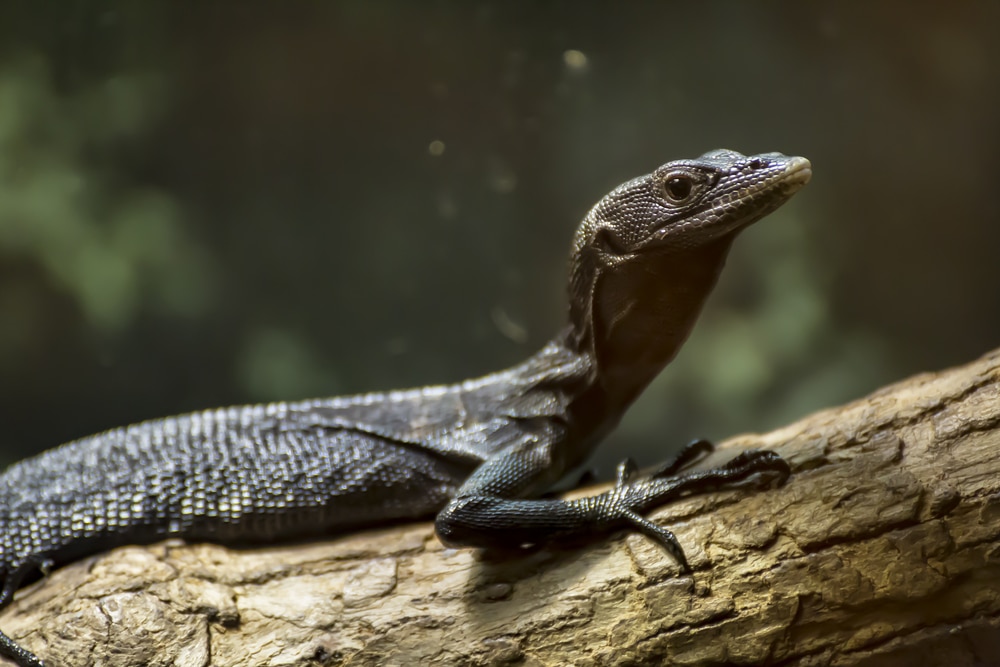Descriptions and keeping tips for four monitor species. For expert reptilekeepers only
Of all the families of lizards that a new keeper could casually and successfully maintain without much preparation or pre-planning, the family Varanidae, the monitor lizards, is not it. While keeping monitors can be a rewarding and successful long-term endeavor, it does take a certain skill set to maintain the largest of the world’s lizards, including a working knowledge of their biology and habits, the proper equipment to house them, and a commitment that these long-lived reptiles (anywhere from 5 to nearly 25 years, depending on species) require. I’ve personally kept a number of monitor species throughout t the years, and I find these animals to be among the most intelligent and cunning of all lizard species.
Read More
Expert Care For the White Throated Monitor
5 Tips For Keeping The Savannah Monitor
Monitors, as a family, present the keeper with a very wide range of options. Some species are quite inexpensive, such as the Nile monitor (Varanus niloticus), which may sell for as little as $25, while others may cost much more, such as the green tree monitor (V. prasinus), which sells for anywhere from $500 to $700. Some species are slow and docile, while others are notoriously aggressive. And some are lightweight, arboreal insectivores, such as the black tree monitor (V. beccarii), while others are hefty, ground-dwelling carnivores, like the savannah monitor (V. exanthematicus). All in all, the family Varanidae is a diverse group of large, powerful lizards, none of which should be purchased on a whim or housed in under-sized environs.
Perhaps the most important part of getting involved with the monitor lizards is to intimately know the exact species that you are purchasing. Even though they are close kin to one another, different species of monitor can have very different needs in captivity; this may include diet, behavior, lighting, habitat size, relative humidity, and a host of other needs and conditions. With this diversity in mind, let’s take a closer look at four monitor species.
Black Tree Monitor
The black tree monitor (V. beccarii) is one of my personal favorites. Native to the island chains surrounding Papua New Guinea, the black tree monitor is a lightweight species with a snout-to-vent length of only one-third its total length; the rest of this animal’s length occurs in its semi-prehensile tail. Adapted for a life in the forest canopy, this lizard has long, sharp claws, semi-adhesive pads in the center of its feet, and a semi-prehensile tail that aids it in the treetops by curling around branches and granting stabilization as the monitor moves from branch to branch.
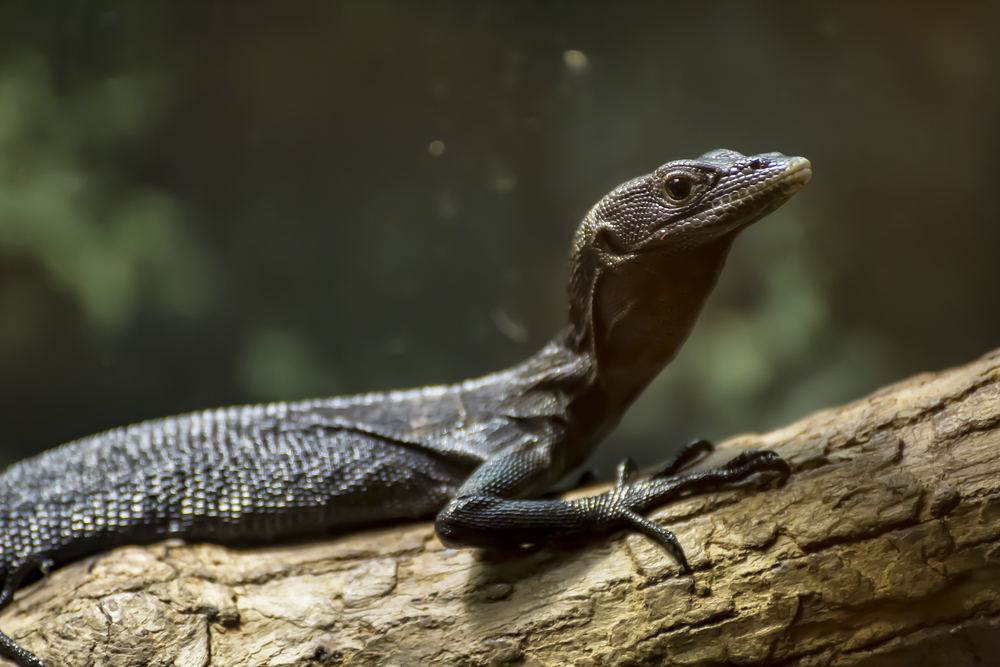
shutterstock/isaac mok
The black tree monitor is small compared to other monitor species, maxing out at less than 48 inches.
As its name suggests, the black tree monitor is completely black at adulthood, but as a hatchling and sub-adult, this species wears a gray mantle speckled with yellow and cream-colored spots, freckles and ocelli. The teeth of the black tree monitor are long, sharp and curve inward, allowing the animal to better hang on to prey in the canopy with reduced risk of dropping it to the forest floor below. Its diet in the wild includes all manner of invertebrates, rodents, birds, bird eggs, arboreal snakes and other lizard species. While it will descend to the forest floor occasionally, this lizard prefers to hunt, bask and even sleep in the canopy.
Although not as commonly kept as some other monitor species, the black tree monitor makes an excellent pet for the serious herp enthusiast. Growing to a maximum length of less than 48 inches (most adults seldom exceed 36 to 42 inches, the males being the larger of the two sexes), this small monitor species (compared to others) requires a very tall, elaborately furnished enclosure if it is to thrive in the captive environment. I recommend either a custom-built enclosure of not less than 6 feet in height, 5 feet in width and 3 feet in depth, or a similarly sized, all-glass terrarium fitted with a secure, heavy-gauge screen lid.
Furnish the enclosure with several stable climbing branches (affixed to the enclosure walls by screws or bolted into a stable wooden base) and plenty of living or artificial plants and vines to simulate the jungle canopy. Flooring is of minimal concern, as black tree monitors rarely descend to the ground. If you have constructed a large, natural vivarium, then flooring may consist of soil, leaf-litter and/or similar materials to accommodate your pet.
As is true with all monitor species, the more room you can provide your pet, the better. Large, screen-walled habitats with wooden framing and screen roofs (to accommodate overhead lighting apparatus) are the most cost-effective way to house a black tree monitor, but properly maintaining temperature and relative humidity in a screen-walled enclosure can be difficult. Lighting should consist of at least eight hours daily of full-spectrum ultraviolet lighting. Many hobbyists build movable habitats and wheel them outside on sunny days so that the monitor may benefit from natural sunlight. Another option is to have a separate, smaller habitat outside that is very securely built, where you can place your lizard during the day. Make sure it has a shady retreat, so that the monitor may escape the heat of the sun if necessary. Never leave your monitor in the direct sun without a shady retreat, as any species of reptile can overheat and expire under such conditions.
Although they are very manageable in size, black tree monitors can be nervous. While most high-strung or threatened monitors will hiss, puff their throats and lash with their tails, the black tree monitor almost always tries to flee by rapidly ascending higher into the canopy. Cornered or rudely handled specimens may also release their cloacal contents on their handlers. Although gentle and regular handling can help to partially tame these lizards, black tree monitors make better observational pets than “petting” pets. Then again, few monitor species are renowned for being comfortable with frequent handling.
Feeding pre-killed rodents and chicks may help to decrease a monitor’s wildness and nervousness in captivity. In addition to such prey, the black tree monitor may be fed crickets, mealworms and virtually any other type of cultivated insect. Processed foods manufactured specifically for monitors can also comprise a viable part of your black tree monitor’s diet. Feed your pet daily, and supplement every other day’s meals with calcium dust or liquid.
Maintain daily ambient temperatures in the mid-80s Fahrenheit, with a basking spot reaching into the high 90s to low 100s. Nightly ambient temperature drops of 10 degrees or so in are acceptable. Maintain a relative humidity of 60 percent or higher at all times. Offer your black tree monitor water by securing one or more small, shallow dishes amid the climbing branches. Misting the habitat with a spray bottle multiple times daily is also highly recommended. I also recommend placing a large, shallow pan of water on the floor of the enclosure, because even though they may not descend often, black tree monitors will emerge from the canopy to swim in pools and streams. Like most monitors, V. beccarii has a tendency to defecate in its water dish, so diligence in maintaining clean water supplies is paramount. Make sure to leave a branch or other haul-out in the large water dish, so that your monitor may easily climb out.
Sadly, the black tree monitor has a shorter lifespan than most monitors. A healthy specimen may live for as few as 5 years, or in rarer cases, as many as 10. Virtually all specimens available in the pet trade are imported from the wild, as this species is very seldom bred in captivity. As such, newly acquired specimens, which may cost anywhere from $200 to $250, should be immediately inspected by a herp veterinarian and treated for internal parasites.
With care and the proper husbandry, the black tree monitor makes a unique and visually spectacular pet. While it is not the most handle-friendly of lizards, it is wonderful to observe and maintain in its arboreal habitat.
Savannah Monitor
The next species on the docket is the very popular, ground-going savannah monitor (V. exanthematicus). Native to the warm forests and grasslands of tropical Africa, this lizard is a devout carnivore. Its wild diet is comprised of primarily insects, small rodents, the eggs and chicks of ground-nesting birds, and virtually all other vertebrates small enough to fit in the monitor’s mouth. Rotting carrion has also been shown to comprise a notable percentage of the wild savannah monitor’s diet.
This stocky lizard grows to 48 to 55 inches in length and may weigh more than 30 pounds. It is substantially larger than its black tree cousin discussed previously. As is true with most monitor species, male savannahs are the larger of the two sexes.
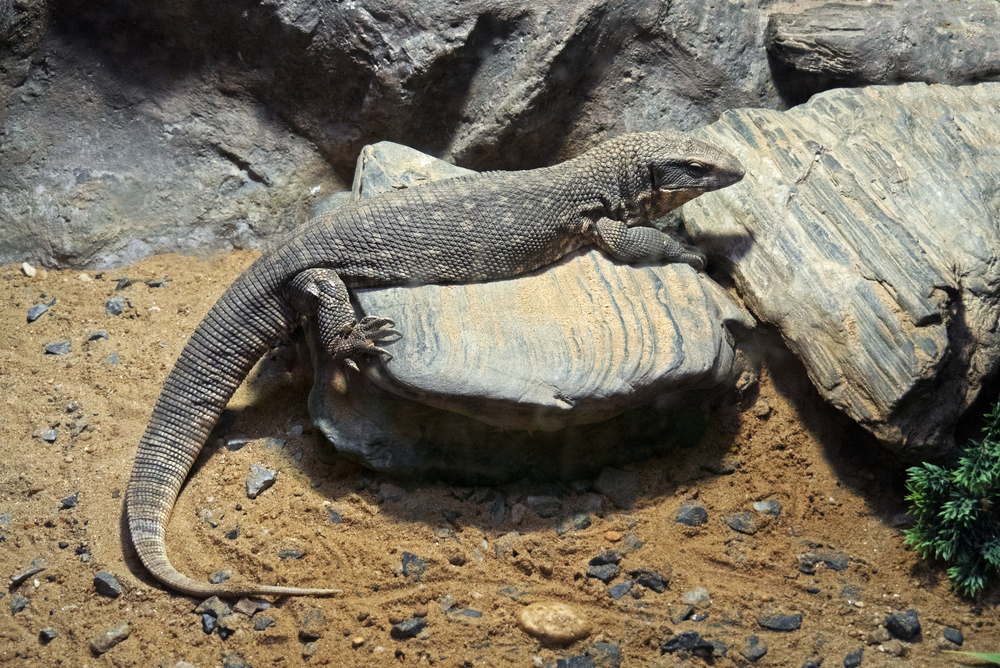
shutterstock/cherdchai chalvimol
Large, adult savannah monitors have powerful limbs and sharp claws, so a special pair of gloves (made specifically for handling large reptiles or birds of prey) may be necessary to avoid experiencing an unwitting injury from your pet’s talons.
It is easy to see why the savannah monitor has been a mainstay in the pet reptile industry for so long. Wearing a basal coat of tan to sandy-tawny coloration that is freckled with cream to off-white spots and ocelli, and banded about the tail with broken rings of the same coloration, the savannah monitor is one of the more attractive monitors available to the average hobbyist. Often sold in pet shops as hatchlings, these monitors start out as demure, 5- to 8-inch babies. So, buyer beware; make sure you will have adequate space and resources to house a growing savannah monitor.
I recommend nothing smaller than a 30-gallon long tank for a small savannah monitor, a 55 gallon for a larger specimen of 18 inches or so, and a larger, custom-made enclosure for subadult and adult specimens. Many serious keepers of any species of monitor have dedicated entire rooms in their homes to their scaly friends. All monitor species need room to roam, and the savannah monitor is no exception. Letting this animal roam freely in a contained environment, such as an inescapable pen or closed-off room, is the best option for the long-term welfare of your pet. For information regarding the construction of such a large enclosure, I recommend reading Giant Lizards (TFH Publication, 2009) by Robert Sprackland.
When building a terrarium environment for the savannah monitor, keep in mind that this lizard is a forest-dwelling species. It thrives in warm, yet semi-humid, environments and enjoys high heat and plenty of ground cover. Hides are a must, with higher levels of humidity inside them. Achieve this by heavily misting the substrate beneath any hides. These dark, humid retreats will simulate the burrows and tunnels where savannah monitors live in the wild.
I find that the best substrate for a savannah monitor is a mixture of plain potting soil and cypress bark, mixed one part bark to two parts soil. Eco Earth, made from coconut fiber, also makes spectacular bedding for this, and virtually all other, species of monitor lizard. Small savannah monitors may have live plants anchored in their terrariums; larger monitors will likely trample or otherwise destroy plants. Succulents such as aloe vera may work well for this species.
Maintain ambient temperatures in the mid-80s in your savannah monitor’s enclosure; warmer basking spots up to 100 degrees are recommended, as are slightly cooler (and more humid) hideaways. This temperature variety allows your pet to thermoregulate as it would in nature. Misting your savannah monitor’s substrate several times weekly will help keep humidity levels near the recommended 60 to 65 percent.
UV bulbs are absolutely necessary. I recommend eight to 12 hours of full-spectrum UVA and UVB lighting for your savannah monitor daily.
Easily one of the most docile, handle-friendly monitors you could ever own, the savannah monitor tames to gentle, regular handling and can be a pet in the truest sense of the word. Acquiring your monitor at a young age is crucial in it becoming a tame pet. When it is small, handle your savannah monitor by gently nudging it into your hand or allowing it to crawl along your hands and arms. Take care to handle it over a couch, bed or low over a counter, such that it is not at risk of falling onto a hard floor and potentially injuring itself. Once it gets a little size on it, you may safely pick up your savannah monitor and hold it by the midsection and back hips, taking care to support its weight and not grab it by the tail. Unlike other lizards, varanids do not have regenerative properties in their tails. Once a monitor’s tail is lost, it’s lost forever.
Large, adult savannah monitors have powerful limbs and sharp claws, so a special pair of gloves (made specifically for handling large reptiles or birds of prey) may be necessary to avoid experiencing an unwitting injury from your pet’s talons. After handling any pet reptile, make sure you wash your hands with antibacterial soap to avoid any possible contamination. Like all animals, including humans, monitors can carry bacteria on their skin. In the case of monitors, bacteria can hide in the interstitial spaces between their scales, as well, especially if the reptile is housed in unsanitary conditions by a lax or careless keeper. Such unsanitary conditions, coupled with unsafe handling practices, can lead to bacterial infection for both the keeper and the kept.
Feeding is another great aspect of keeping the savannah monitor; these hardy reptiles are eating machines! Virtually everything that moves is on the menu, so you will have to be diligent in ensuring that your pet doesn’t eat too much. Obesity, and the complications and disorders that accompany it, are the leading causes of death among savannah monitors. Diets that are too fatty or too rich in meat proteins are dangerous for the long-term well-being of your savannah monitor.
Feed your pet a varied diet of insects: crickets, mealworms, wax worms, grasshoppers and roaches (farm-cultivated insects and those sold through your pet shop or online). Savannah monitors also love eating night crawlers (earthworms). Cheaply available in bait shops (even large department stores often sell cups of night crawlers in their sporting goods departments), these protein-rich invertebrates will make a great addition to your savannah’s diet.
White-Throated Monitor
A close cousin of the savannah monitor is the white-throated monitor (V. albigularis). This animal, which occurs in a number of subspecies, grows to considerably longer lengths (adult males may reach 6 feet) and wears a much more striking coat of colors. Juvenile coloration between the white-throated and the savannah monitor is hard to distinguish, but as specimens mature, the savannah will retain its tawny, earthy coloration, while the base color of the white-throat will darken to a slate-gray hue. The lighter spots and bands on this animal, however, are much brighter and more striking than similar markings on the savannah monitor, and some white-throated monitors may take on a light, alabaster shade over the entire body. The morphology of the head is slightly different from the savannah’s, as well; the sharp snout of the savannah monitor is replaced by a bulbous snout in the white-throated monitor.
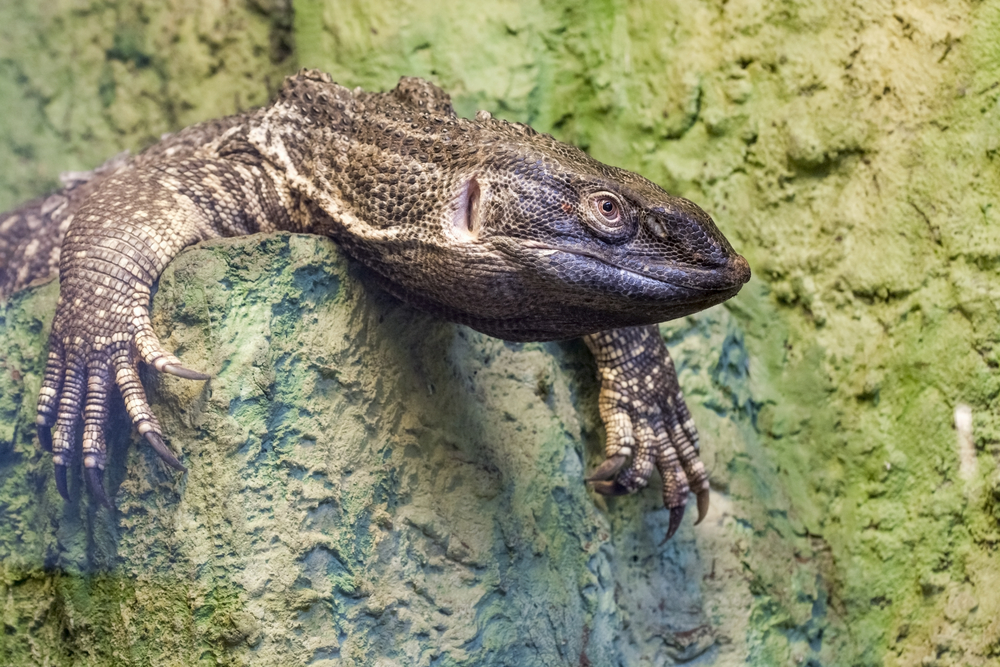
shutterstock/belizar
The white throated monitor, which occurs in a number of subspecies, grows to considerably long lengths (adult males may reach 6 feet) and wears a much more striking coat of colors.
Hailing from the southern half of Africa, the white-throated monitor is usually gentle, but patience and diligence is still required when trying to get them to tame down and adjust to the human touch.
One major difference between the white-throated monitor and the savannah monitor is the purchase price. At the time of this writing, my local pet store is selling savannah monitors for $24.99 each. A white-throated monitor on custom order at that same shop will cost $150.
Aside from the size difference at maturity, these two lizards may be housed under the same conditions as previously described for the savannah monitor.
Nile Monitor
The beautiful, but temperamental, Nile monitor (V. niloticus) boasts the title of the largest lizard in Africa. It is estimated to be capable of reaching five feet in length with a weight of around 45 pounds. When sold as a 10-inch long juvenile that weighs only a few ounces, however, this animal can be very deceptive in the pet shop, and many hobbyists have purchased a Nile monitor without knowing what they are getting themselves into.
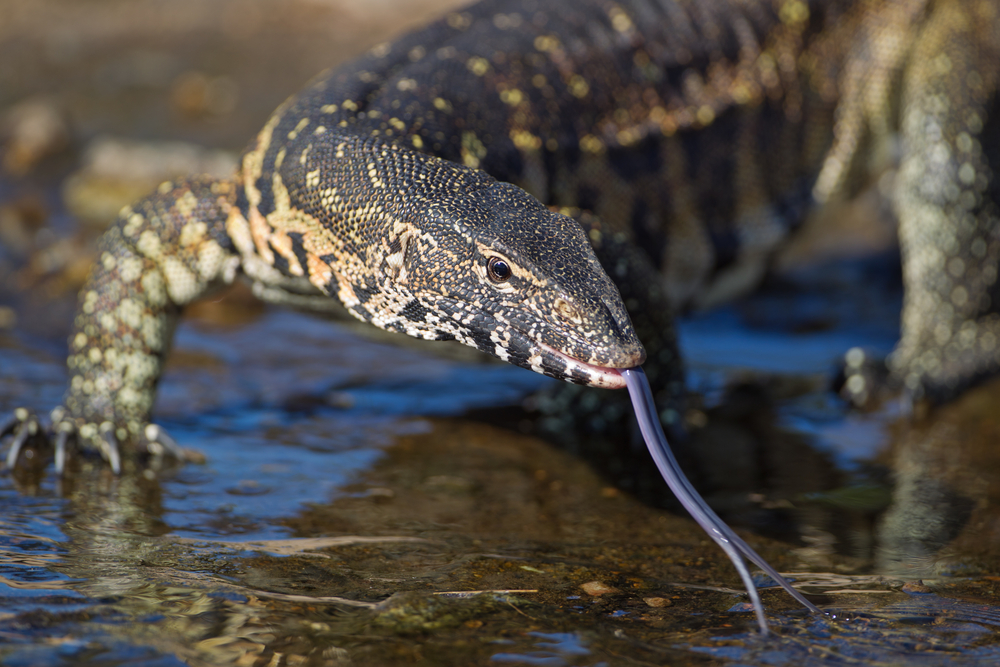
shutterstock/arnoud Quanjer
The nile monitor is a massive lizard for expert keepers only.
In appearance, the Nile monitor is very attractive. Its base coloration is slate to gray to bluish, with bands comprised of yellow to whitish ocelli, spots and freckles. These bands cover the dorsum along the back and completely encircle the tail. The head is similarly dark with lighter speckling and is honed to a very sharp snout.
While it has received something of an undue reputation as a truly evil lizard of terrible disposition, the Nile monitor, if properly housed and cared for, can be much more enjoyable than urban legend would have you believe. Housed in adequately sized terraria as juveniles, these lizards, like the savannah and white-throated monitors, will require their own room or pen as adults.
Juveniles require daily feedings of insects, as they have a very high metabolic rate and need to consume large amounts of food to grow properly. Provide plenty of arboreal retreats to juveniles, as they are devout climbers. When small, these lizards may be housed exactly as described for the black tree monitor. Larger adults, however, seldom leave the ground, and larger basking spots and larger pools of water become necessary, as this riverine species likes to soak and swim. Basking hotspots should reach 110 degrees, while cooler retreats are absolutely necessary, as well. After your Nile monitor reaches 30 inches, provide it with amply sized environs (as well as lighting, water, etc.) as described for the savannah monitor.
Nile monitors are aggressive if improperly conditioned to human touch. Specimens that are not often handled will puff their throats, give a hissing exhalation of breath, lash violently with their tails and, if further aggravated, will empty their cloacal contents and bite repeatedly, often twisting and turning their heads to inflict deep, tearing wounds. Proper, regular handling from the time the lizard is very young, coupled with a diet of exclusively pre-killed prey (to dampen this species’ so-called “killer instinct”) can make all the difference in the world in calming and conditioning an otherwise hostile Nile monitor.
Even though I believe its nasty reputation may not be entirely deserved, the Nile monitor is still a very large species that may exhibit an occasional temperamental outburst. This species should definitely be kept only by the expert hobbyist.
Do Your Research First
If you’ve been thinking about keeping a pet monitor lizard of any kind, I salute your efforts, and I encourage you to read all you can on the animals before taking the plunge. Make sure you are able to meet the commitment that a monitor of any type requires, including time, money, space, effort and quality of life. Remember, it’s not enough that your pet survives under your care—it must thrive. Know your chosen monitor inside and out before you buy. The time and money you’ll save, the amount of effort you’ll expend, and the time and quality of years you’ll share with your reptilian pet will be as long and as enriching as is possible with these, the largest and most intelligent lizards in the world.
Phil Purser, Ph.D., lives in Tampa, Florida, where he is a professor at Hillsborough Community College. An avid angler and naturalist, Phil’s areas of reptile expertise include rosy boas, geckos, and all manner of colubrid snake species. Phil’s greatest reptilian passion, however, are the rattlesnakes.

